|
Outdoor Portrait: (679 k)
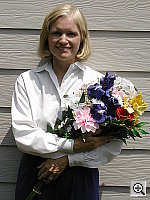 The extreme tonal range of this image makes it a tough shot for many digicams, which is precisely why we set it up this way. The object is to hold highlight and shadow detail without producing a "flat" picture with muddy colors, and the Coolpix 775 had a little trouble with the high contrast lighting. The shot at right has a +0.6 EV exposure compensation adjustment, which produced slightly dark midtones while just barely preserving the highlights. Adjusting the exposure compensation to +1.0 EV produces brighter midtones but loses too much highlight detail. We shot this with the Manual (696 k) white balance setting, as it resulted in more natural color than the Daylight (684 k) and Auto (675 k) white balances. Color looks good, albeit slightly understated, and the blue flowers show some purple tints (a tough blue for many digicams to get right). Good detail in the shadows, though noise is a little high. The image is rather soft overall, apparently due to the very small f/10.3 aperture the 775 has to use in very bright lighting conditions. The table below shows an exposure series from zero to +1.3 EV. The extreme tonal range of this image makes it a tough shot for many digicams, which is precisely why we set it up this way. The object is to hold highlight and shadow detail without producing a "flat" picture with muddy colors, and the Coolpix 775 had a little trouble with the high contrast lighting. The shot at right has a +0.6 EV exposure compensation adjustment, which produced slightly dark midtones while just barely preserving the highlights. Adjusting the exposure compensation to +1.0 EV produces brighter midtones but loses too much highlight detail. We shot this with the Manual (696 k) white balance setting, as it resulted in more natural color than the Daylight (684 k) and Auto (675 k) white balances. Color looks good, albeit slightly understated, and the blue flowers show some purple tints (a tough blue for many digicams to get right). Good detail in the shadows, though noise is a little high. The image is rather soft overall, apparently due to the very small f/10.3 aperture the 775 has to use in very bright lighting conditions. The table below shows an exposure series from zero to +1.3 EV.
Exposure Compensation Settings:
0 EV
1/ 344
F/ 10.6
(655 k)
|
0.3 EV
1/ 282
F/ 10.6
(650 k)
|
0.7 EV
1/ 213
F/ 10.6
(679 k)
|
1.0 EV
1/ 141
F/ 10.6
(698 k)
|
1.3 EV
1/ 108
F/ 10.6
(702 k)
|
|
|
| |
Closer Portrait: (723 k)
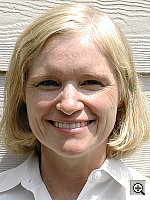 The C775 performs much better in this closeup shot than in the longer portrait shot above. The 3x zoom lens helps prevent any distortion of the model's features, and detail is much stronger than in the shot above. (Apparently, the light level was enough lower here that the 775 could use its larger f/4.7 aperture, which results in much sharper pictures.) Skin tones are pretty good, and overall color is very nice. Shadow detail is great, with only moderate noise. Our main shot has no exposure adjustment at all, which produces bright midtones and only slightly blown-out highlights. The table below shows the results of a range of exposure settings from zero to +1.0 EV. The C775 performs much better in this closeup shot than in the longer portrait shot above. The 3x zoom lens helps prevent any distortion of the model's features, and detail is much stronger than in the shot above. (Apparently, the light level was enough lower here that the 775 could use its larger f/4.7 aperture, which results in much sharper pictures.) Skin tones are pretty good, and overall color is very nice. Shadow detail is great, with only moderate noise. Our main shot has no exposure adjustment at all, which produces bright midtones and only slightly blown-out highlights. The table below shows the results of a range of exposure settings from zero to +1.0 EV.
Exposure Compensation Settings:
0 EV
1/ 612
F/ 4.7
(723 k)
|
0.3 EV
1/ 440
F/ 4.7
(700 k)
|
0.7 EV
1/ 344
F/ 4.7
(707 k)
|
1.0 EV
1/ 273
F/ 4.7
(745 k)
|
|
|
|
Indoor Portrait, Flash: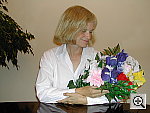 (705 k) (705 k)
The 775's flash does a good job illuminating the subject, though it underexposed slightly here if we didn't use any flash exposure compensation. The background incandescent lighting produces a slight yellowish-orange color cast in the background, which fades with the +0.6 and +1.0 EV adjustments. Color looks best at the +0.3 EV adjustment setting, but the 775 maintains good color throughout the series.
Exposure Compensation Settings:
|
|
|
Indoor Portrait, No Flash: (749 k)
|
Auto White Balance
|
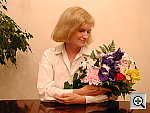 |
|
Incandescent White Balance
|
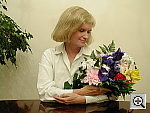 |
|
Manual White Balance
|
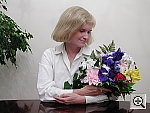 |
|
Party Mode
|
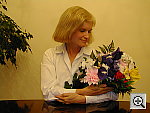 |
This shot is always a very tough test of a camera's white balance capability, given the strong, yellowish color cast of the household incandescent bulbs used for the lighting, and the 775's Manual (732 k) white balance setting does an excellent job. The Incandescent (758 k) white balance setting has a warm, yellow cast, while the Auto (764 k) setting results in a strong magenta image. We also tried a shot with the camera's Party (844 k) exposure mode, which produced a very yellow image. (We suspect "Party" is intended for darker surroundings, where the camera would have fired the flash. If the flash had been used, the color balance would have been much more accurate.) We selected a +1.0 EV exposure adjustment for our main shot, as anything brighter created splotchy highlights on the white shirt. Though the blue flowers are slightly purple, and skin tones are rather magenta, the overall color is fairly accurate, much better than most cameras do on this test.
Exposure Compensation Settings:
|
|
|
House Shot: (629 k)
|
Auto White Balance
|
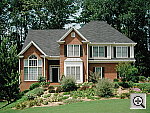 |
|
Daylight White Balance
|
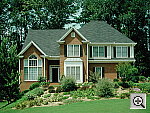 |
|
Manual White Balance
|
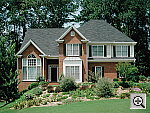 |
We chose the Auto (629 k) white balance setting for our main selection, as the overall color balance looked the most natural (the Daylight (626 k) setting appeared warm and the Manual (622 k) setting was just slightly cool). Color is good, with accurate saturation throughout. A reasonable amount of fine detail is visible in the tree limbs and house front, though details are slightly soft throughout the frame.
|
|
| |
Far-Field Test (619 k)
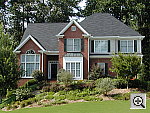 This image is shot at infinity to test far-field lens performance. NOTE that this image cannot be directly compared to the other "house" shot, which is a poster, shot in the studio. The rendering of detail in the poster will be very different than in this shot, and color values (and even the presence or absence of leaves on the trees!) will vary in this subject as the seasons progress. In general though, you can evaluate detail in the bricks, shingles and window detail, and in the tree branches against the sky. Compression artifacts are most likely to show in the trim along the edge of the roof, in the bricks, or in the relatively "flat" areas in the windows. This image is shot at infinity to test far-field lens performance. NOTE that this image cannot be directly compared to the other "house" shot, which is a poster, shot in the studio. The rendering of detail in the poster will be very different than in this shot, and color values (and even the presence or absence of leaves on the trees!) will vary in this subject as the seasons progress. In general though, you can evaluate detail in the bricks, shingles and window detail, and in the tree branches against the sky. Compression artifacts are most likely to show in the trim along the edge of the roof, in the bricks, or in the relatively "flat" areas in the windows.
This is our ultimate "resolution shot," given the infinite range of detail in a natural scene like this. The 775 picks up a moderate amount of fine detail, though details are again slightly soft throughout the frame. As we've noticed on many digicams, the fine foliage details have less definition than the straighter details of the artificial surfaces (such as the bricks and shingles). The 775 handles the extreme tonal range of the subject well, holding decent detail in the strong highlights, and good detail in the background brick pattern. Color looks good, though the overall color balance is a little cool. The table below shows our resolution and quality series, followed by a sharpness series.
Resolution Series:
Sharpness Series:
|
|
| |
Lens Zoom Range
We've received a number of requests from readers to take shots showing the lens focal length range of those cameras with zoom lenses. Thus, we're happy to present you here with the following series of shots, showing the field of view with the lens at full wide angle, the lens at full 3x telephoto, and the lens at full telephoto with 2x digital zoom enabled. The 775's lens covers a range equivalent to a 38-115mm zoom on a 35mm film camera. Following are the results at each zoom setting.
|
|
| |
Musicians Poster (610 k)
|
Auto White Balance
|
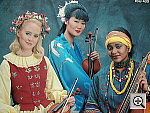 |
|
Daylight White Balance
|
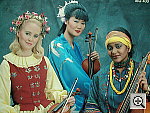 |
|
Manual White Balance
|
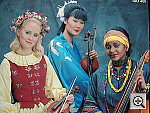 |
For this test, we shot with the Auto (610 k), Daylight (605 k), and Manual (609 k). We were a little surprised that the auto white balance produced the best result here, as cameras are usually fooled by the overwhelming amount of blue in the background.) Though the Auto setting is slightly warm, we felt the skin tones were more natural. Color is good throughout the frame, with a fairly accurate blue value on the Oriental model's robe (despite the greenish tint from the warm color balance). Detail and resolution also look nice, with moderate noise present in the shadows and blue background. |
|
|
Macro Shot (395 k)
|
Standard Macro Shot
|
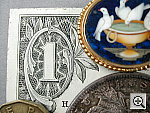 |
|
Macro with Flash
|
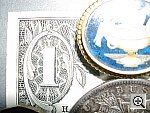 |
The 775 does an excellent job in the macro category, capturing a minimum area of just 1.71 x 1.29 inches (43.54 x 32.45 millimeters). Resolution is high, with sharp, clear details on the surface of the dollar bill. The brooch and coins are very soft, due to the limited depth of field this close. Corner softness is slightly noticeable, and there's some barrel distortion, but overall color looks very accurate. Overall, an excellent macro performance! The 775's flash (363 k) proves ineffective at this close range, overexposing the top right corner of the frame and producing a shadow in the lower left corner.
|
|
|
"Davebox" Test Target (560 k)
|
Auto White Balance
|
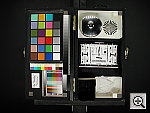 |
|
Daylight White Balance
|
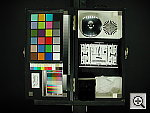 |
|
Manual White Balance
|
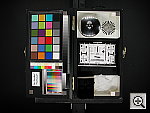 |
We shot samples of this target using the Auto (586 k), Manual (560 k), and Daylight (596 k) white balance settings, choosing the Manual setting for our main selection. (The Auto shot was slightly yellow, while the Daylight shot was too warm and greenish.) Exposure is nearly right, with good tonal distribution. Overall color is accurate and bright, with good saturation. Shadow and highlight detail are both good, with moderate noise in the background and shadows. An excellent performance!
|
|
|
Low-Light Tests
The 775 performs fairly well in our low-light test, given the camera's lack of full manual exposure control. The camera provided usable images down to about one-half foot-candle (about half as bright as a well-lit city street at night) with good color. (We therefore predict that the 775 would do a very good job for night photography in city settings.) The 775 managed to capture images as low as 1/16 foot-candle, but they were really too dim for use at that level. Noise remains moderately low, considering the low light level. (We refer interested readers to Mike Chaney's Qimage Pro software for a program that does an excellent job of removing noise of this sort without overly disturbing the underlying picture information.) The table below shows the best exposure we were able to obtain for each of a range of illumination levels. Images in this table (like all of our sample photos) are untouched, exactly as they came from the camera.
8fc
88lux |
4fc
44lux |
2fc
22lux |
1fc
11lux |
1/2fc
5.5lux |
1/4fc
2.7lux |
1/8fc
1.3lux |
1/16fc
0.67lx |

630.7 KB
1/ 6
F2.8
|

658.2 KB
1/ 4
F2.8
|

722.4 KB
1/ 3
F2.8
|

730.6 KB
1/ 2
F2.8
|

669.6 KB
1
F2.8
|

321.5 KB
1
F2.8
|

260.6 KB
1
F2.8
|

197.3 KB
1
F2.8
|
|
|
|
Flash Range Test
In our testing, we found the 775's flash to be effective though somewhat dim at all distances we tested, not being noticeably darker at 14 feet than it was at 8. (Plan on routinely using a little exposure boost on your flash exposures.) Below is our flash range series, with distances from eight to 14 feet from the target.
| 8 ft |
9 ft |
10 ft |
11 ft |
12 ft |
13 ft |
14 ft |

293.6 KB
1/ 213
F4.5
|

318.4 KB
1/ 119
F4.8
|

302.9 KB
1/ 184
F4.9
|

323.6 KB
1/ 164
F4.9
|

396.1 KB
1/ 155
F4.9
|

387.1 KB
1/ 138
F4.9
|

388.6 KB
1/ 134
F4.9
|
|
|
|
ISO-12233 (WG-18) Resolution Test (691 k)
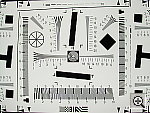 The 775 performed well on our "laboratory" resolution test chart. It showed (very minor) artifacts in the test patterns at resolutions as low as 600 lines per picture height, in both horizontal and vertical directions, but we found strong detail out to at least 750 lines. "Extinction" of the target patterns didn't occur until about 850 lines horizontally, 950 lines vertically. Overall, a good performance, but we again noticed the slight softness that characterized our other test photos with the 775. The 775 performed well on our "laboratory" resolution test chart. It showed (very minor) artifacts in the test patterns at resolutions as low as 600 lines per picture height, in both horizontal and vertical directions, but we found strong detail out to at least 750 lines. "Extinction" of the target patterns didn't occur until about 850 lines horizontally, 950 lines vertically. Overall, a good performance, but we again noticed the slight softness that characterized our other test photos with the 775.
Optical distortion on the 775 is a little high at the wide angle end, where we measured an approximate 0.97 percent barrel distortion. The telephoto end fared much better, as we found only two pixels of pincushion distortion (about 0.13%). Chromatic aberration is very low, showing only about one or two lightly-colored pixels in the far corners. (This distortion is visible as a very slight colored fringe around the objects at the edges of the field of view on the resolution target.)
Resolution Series, Wide Angle:
Resolution Series, Telephoto:
Sharpness Series:
|
|
|
Viewfinder Accuracy/Flash Uniformity
The 775's optical viewfinder is a little tight, showing approximately 88 percent frame accuracy at wide angle, and about 84 percent at telephoto. The LCD monitor fares much better, showing approximately 98 percent of the image area at both wide and telephoto settings. Given that we generally prefer LCD monitors to be as close to 100 percent accuracy as possible, the 775's LCD monitor does a great job here. Flash distribution is even at wide angle, with only the slightest falloff at the corners of the frame. Likewise, flash distribution is very even at the telephoto setting. (As noted above, we'd like to see the flash brighter overall, but this is by far the most even flash coverage we've seen in a digicam in recent memory.)
|
|
|
|
|
|
|
|
|

Follow Imaging Resource: